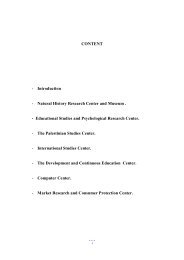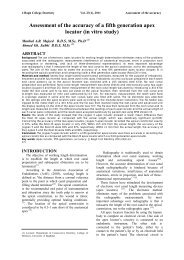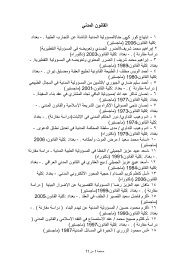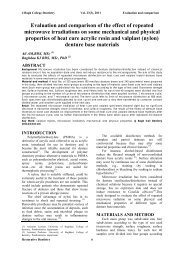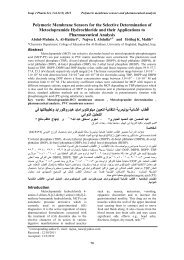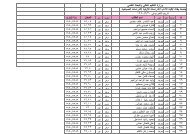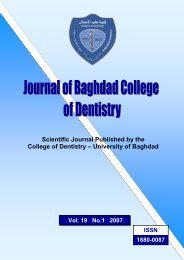Vol 21 No. 1
Vol 21 No. 1
Vol 21 No. 1
Create successful ePaper yourself
Turn your PDF publications into a flip-book with our unique Google optimized e-Paper software.
J Bagh College Dentistry <strong>Vol</strong>. <strong>21</strong>(1), 2009 Closed reduction for...<br />
mucoperiosteal attachment and its blood supply<br />
to the osseous fragments in open procedures).<br />
Closed reduction and indirect skeletal<br />
fixation was used as the modality of choice in<br />
this study for all cases. Arch bars (Erich pattern)<br />
applied due to their avaliability, ease of<br />
application and shorter operation time. Displaced<br />
fractures were treated initially with interarch<br />
elastics applied to the arch bars (Figure 2), and it<br />
was noted that fracture displacement will be<br />
reduced wihin short time (5 minutes) provided<br />
that it was applied in the right way (no crossing).<br />
Complications were common in these series<br />
with 17 out of 32 patients experiencing one or<br />
more complications 53.1%, this high<br />
complication rate was acceptable since many of<br />
complications were transient. There is a<br />
relatively high rate of wound infection in this<br />
study 16.2% compared with Zaytoun et al (31)<br />
(24)<br />
12% and Akhlaghi & Aframian-Farnad<br />
11.4%, this high rate may be explained that many<br />
of missile injuries could not be treated in a strict<br />
aseptic techniques which were not always<br />
possible in the event of mass casualities due to<br />
hospital facilities.<br />
The incidence of significant bone loss was<br />
35.13% in 13 patients who subsequently require<br />
the use of autogenous bone graft. Chambers &<br />
Scully (32) reported a less incidence of bone loss<br />
from the mandible 27.5% in 16 out of 58 patients<br />
with missile injuries. The loss is related to the<br />
high energy imparted at impact and to the effect<br />
of shock wave and temporary cavitation<br />
produced by high velocity missile resulting in<br />
extensive tissue damage.<br />
Fracture of the mandible within the course of<br />
inferior alveolar nerve frequently results in nerve<br />
injury and altered neurosensory function; this<br />
may be due to direct injury or secondary injury<br />
due to the line of fracture or missile path or a<br />
secondary insult due to manipulation and<br />
temporary reduction of the fracture. The<br />
predominant sign was paraesthesia in the lower<br />
lip and chin regions in addition to the gingiva<br />
and teeth which was found in 32.4%. The degree<br />
of nerve injury determine whether the<br />
impairement of sensory function being transient<br />
or permanent.<br />
Occlusal abnormalities reported in 6 patients<br />
16.2% in which minor or gross abnormalities<br />
were seen, this may be due to severe bone<br />
destruction under the influence of muscle pull or<br />
simultaneous severe bone destrucion to upper<br />
jaw and teeth. Minor discrepancies may be<br />
acceptable or can be corrected by selective<br />
grinding of teeth, while gross abnormalities<br />
require further treatment (Figure 5).<br />
Figure 1: 3-d reconstruction life-size model<br />
of facial bones made from CT scan image,<br />
amount of bone loss can be accurately<br />
estimated.<br />
Figure 2: (A) Postoperative view showing<br />
comminuted fracture of left mandibular<br />
angle.<br />
(B) Closed reduction utilizing arch bars &<br />
elastic traction.<br />
(C) Frontal view 3 months after injury.<br />
(D-E) Postoperative occlusal relationship,<br />
note the nice occlusion result.<br />
95<br />
Oral and Maxillofacial Surgery and Periodontology



